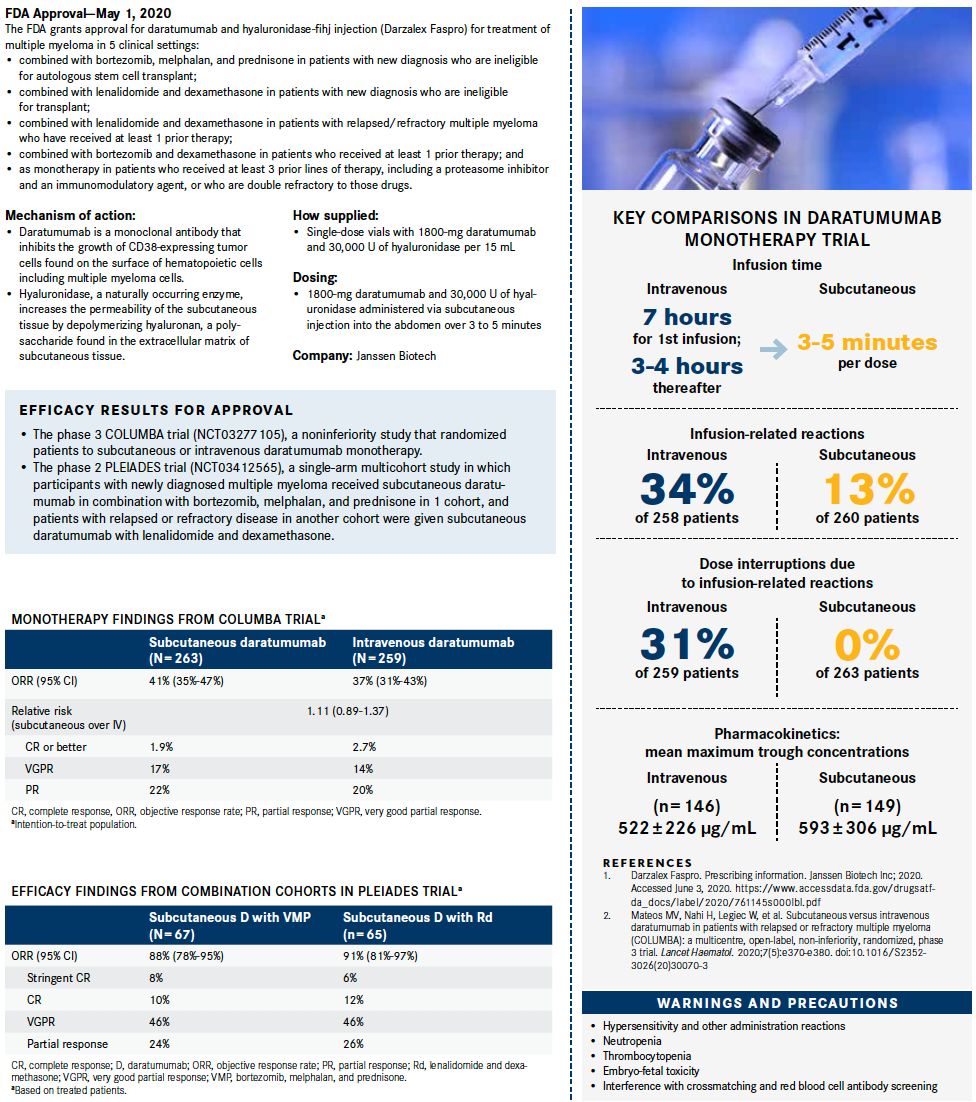Subcutaneous Daratumumab Offers Convenience for Patients With Multiple Myeloma
Nearly 5 years after its approval for patients with multiple myeloma, daratumumab is now available in a formulation that can be administered in a fraction of the time required with the original agent.
Saad Z. Usmani, MD

Nearly 5 years after its approval for patients with multiple myeloma, daratumumab (Darzalex) is now available in a formulation that can be administered in a fraction of the time required with the original agent. On May 1, 2020, the FDA approved subcutaneous daratumumab and hyaluronidase-fihj (Darzalex Faspro), which takes 3 to 5 minutes to administer instead of the hours needed for the drug’s intravenous (IV) form.1
Subcutaneous daratumumab gained indications across 5 regimens for adults in multiple myeloma settings. For patients with a new diagnosis who are ineligible for autologous stem cell transplant, the formulation can be combined with bortezomib (Velcade), melphalan, and prednisone (VMP) and in conjunction with lenalidomide (Revlimid) and dexamethasone (Rd).
In the relapsed/refractory (R/R) setting among patients who received at least 1 prior therapy, the new agent can be used with the Rd regimen or with bortezomib plus dexamethasone. As monotherapy, the drug can be administered to patients who have received at least 3 prior lines of therapy, including a proteasome inhibitor and an immunomodulatory agent, or who are double refractory to those drugs.
IV daratumumab is approved in those settings, as well as in combination with bortezomib, thalidomide (Thalomid), and dexamethasone in patients with new diagnoses who are eligible for transplant and in conjunction with pomalidomide (Pomalyst) and dexamethasone in patients who have received at least 2 prior therapies, including lenalidomide and a proteasome inhibitor.2
The new formulation consists of daratumumab, a monoclonal antibody directed at CD38, and human hyaluronidase, a glycosylated protein that increases the dispersion and absorption of coadministered drugs when given subcutaneously.1
Janssen Biotech, which manufactures daratumumab, collaborated with Halozyme Therapeutics, which develops the drug delivery technology. Halozyme’s Enhanze system works to degrade hyaluronan, a polysaccharide found in the extracellular matrix of the subcutaneous tissue, allowing large volumes (up to 300-600 mL) to be delivered in a single subcutaneous injection.1,3 The recommended dose is 1800 mg of daratumumab with 30,000 U of hyaluronidase per 15 mL administered subcutaneously to the abdomen over 3 to 5 minutes, starting with weekly doses and then varying in frequency according to the indication.
By comparison, IV daratumumab, originally approved in 2015, has a recommended infusion rate for the first hour of treatment of 50 mL/hour during week 1 and 2 doses, increasing to 100 mL/hour for week 3 onward if there are no infusion reactions; the maximum infusion rate is 200 mL/hour. The dosing is 16 mg/kg of the patient’s body weight.2
“Subcutaneous daratumumab will be a big convenience for both patients and nurses,” Saad Z. Usmani, MD, a key investigator, said in an interview with OncLive®. “The days can be long for patients. It is highly likely that the subcutaneous formulation, because of the convenience factor and the low infusion reaction and similar efficacy rates, may replace the IV formulation moving forward.
“The most important thing is that the subcutaneous formulation in the 15-mL, premixed syringe can be given in under 5 minutes compared with the IV formulation, where the first IV infusion is about 7 hours, the second is 6 hours, and after that takes about 3 to 4 hours,” added Usmani, who is the division chief of plasma cell disorders and director of clinical research in hematologic malignancies at Atrium Health’s Levine Cancer Institute in Charlotte, North Carolina. He also is a clinical professor of medicine at the University of North Carolina at Chapel Hill School of Medicine.
Clinical and Pharmacokinetic Data
Usmani and colleagues investigated the efficacy of the subcutaneous formulation in the phase 3 COLUMBA study (NCT03277105), a noninferiority trial in which 522 patients with R/R multiple myeloma who received at least 3 prior lines of therapy were randomized to receive monotherapy with subcutaneous (1800 mg/30,000 units) or IV daratumumab (16 mg/kg). Patients in both arms were treated weekly from weeks 1 to 8, once every 2 weeks from weeks 9 to 24, and once every 4 weeks starting with week 25 until unacceptable toxicity or disease progression. The primary end points were overall response rate (ORR) and the pharmacokinetic measures of maximum trough concentration levels before cycle 3.
“After follow-up of 7. months, both of the primary end points were met for the study,” Usmani said. “The overall response was similar in both the patient populations. In the subcutaneous group, the response rate was 41% and it was 37% in the intravenous group. The [trough concentration] levels for both IV and subcutaneous formulation were similar.”
Notably, there was a nearly two-thirds reduction in systemic administration-related reactions for subcutaneous daratumumab compared with IV daratumumab (13% vs 34%, respectively; OR, 0.28; 95% CI, 0.18-0.44; P < .0001).
“The common adverse events were similar in both groups except for the infusion-related reactions, which were much lower in the subcutaneous arm compared with the IV arm,” Usmani said. “That was a big improvement from a patient perspective. The majority of the infusion-related reactions were predominantly grade 1 and 2. Very few grade 3 reactions were seen.”
Additionally, the efficacy of subcutaneous daratumumab was evaluated in the multicohort phase 2 PLEIADES trial (NCT03412565). Findings from 2 cohorts of the nonrandomized study, in which patients received experimental daratumumab as part of a VMP or Rd regimen, are included on the drug’s label. In the daratumumab plus VMP group, which included 67 patients with newly diagnosed multiple myeloma ineligible for transplant, the ORR was 88% (95% CI, 78%-95%). In the daratumumab plus Rd group, with 65 patients with R/R multiple myeloma, the ORR was 91% (95% CI, 81%-97%).1

References:
- Darzalex Faspro. Prescribing information. Janssen Biotech Inc; 2020. Accessed June 3, 2020. https://www.accessdata.fda.gov/drugsatfda_docs/label/2020/761145s000lbl.pdf
- Darzalex. Prescribing information. Janssen Biotech Inc; 2019. Accessed June 3, 2020. https://www.accessdata.fda.gov/drugsatfda_docs/label/2020/761036s027lbl.pdf
- Enhanze drug delivery technology. Halozyme. Accessed June 3, 2020. https://www.halozyme.com/enhanze/overview/default.aspx




